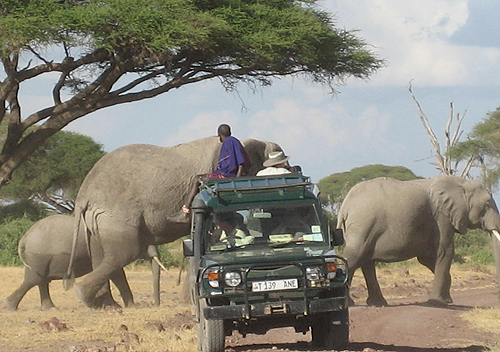
Western wildlife NGOs and local researchers have been working tirelessly on human/elephant conflicts over the past decade. They haven’t gotten very far. It’s hard to keep six tons from doing what it wants.
Tanzania elections are scheduled for the end of the year and new elections in Kenya for the new branches of its legislature will occur next year. One leading candidate in northern Tanzania, Abdilah Ali Warsama, campaigned this weekend on ending elephant harassment of local farms.
He’s not calling on the government to cull elephant… yet. Right now he’s just demanding compensation to the farmers and second, elephant fences.
I’ve never heard of elephant fences.
What Warsama may actually mean is the extremely expensive trenching or construction of deep moats which in several places in East Africa seems to have worked.
I saw a successful trench for myself at the southern end of Uganda’s Queen Elizabeth National Park in the Ishasha last month. It’s a temporary solution, because the earthen moat erodes with time. But this particular 2-meter deep and 2.5-meter wide trench was working and going into its second year.
The problem with trenches is that their goal is to stop wildlife from moving beyond the trench.
Wildlife purists don’t like that. In Warsama’s constituency (the Tanzanian town of Makuyuni, in between Lake Manyara and Tarangire national parks) the African Wildlife Foundation wants to create a corridor for elephants between Manyara and Tarangire.
No successful trench would allow that.
Nothing else has worked: not pepper spray, electric fences or lead-in corridors that try to direct animals away from human habitations.
Tarangire has long been known as a prime elephant park. One of its current attractions – developed only in the last couple years – are congregations of a dozen or more huge bulls hanging around together near park roads as if modeling for tourists.
Normally this many bulls would’t hang out together.
But they’re resting and enjoying the fruits of a night of hawkish delight. These jumbos move out of the park regularly at night to raid nearby farms. Then, lounging in the protection of tourist cameras, they convene just inside the boundaries during the day.
Wasarama is not happy with Tarangire’s new attraction. He pointed out that 250 acres of his constituency’s food crops have been destroyed in the last season, and that four farmers were killed trying to defend their crops.
I don’t doubt it. Last March as my migration safari was zooming along the Tarangire / Makuyuni road at about 80 kmh, we watched a farmer using a huge bola single-handedly as he tried to chase a family of five elephant out of his corn crop.
Wasarama’s campaign issue in Makuyuni is by no means isolated. Similar situations exist outside Bwindi in Uganda and the Aberdare in Kenya.
I see the day coming soon when the human/elephant conflict gets so serious that culling and contained reserves using trenches is the only solution. It’s hard to imagine an alternative.